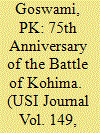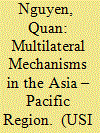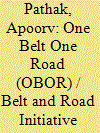|
|
|
Sort Order |
|
|
|
Items / Page
|
|
|
|
|
|
|
| Srl | Item |
| 1 |
ID:
168112


|
|
|
|
|
| Summary/Abstract |
Perched on top of a mountain ridge, some 5,000 feet up in the remote hilly terrain of northeast India, is located the town of Kohima, in the state of Nagaland. During the Second World War (WW-II), one of the most decisive battles on the Burma front took place here – the one that thwarted the Japanese invasion of India and helped turn the tide of the war in the Far East. Like most battles that took place in the South-East Asian Theatre, the Battle of Kohima remains relatively unknown because the world was too preoccupied with Nazi Germany in Europe. The Allied invasion of Europe also steered the spotlight away from the Battle of Kohima which was still being fought when D-Day started. Though off late in April 2013, the Battle of Kohima, along with the Battle of Imphal, was voted as Britain’s greatest battles by the British National Army Museum.
|
|
|
|
|
|
|
|
|
|
|
|
|
|
|
|
| 2 |
ID:
168104


|
|
|
|
|
| Summary/Abstract |
The potency and overwhelming lethal effects of cyber warfare have outpaced the technological development in conventional military weapons space, changing the very character of future wars, and the role of cyber warfare in them. Worldwide cyber warfare is now being acknowledged as the fifth dimension of warfare.
|
|
|
|
|
|
|
|
|
|
|
|
|
|
|
|
| 3 |
ID:
168109


|
|
|
|
|
| Summary/Abstract |
the strategic importance of IOR is ever increasing to the world order in general and Indian sub-continent in particular. India’s central position in IOR lends it immense advantages but at the same time presents far greater challenges. A secure IOR is key to ensuring security of India’s national interests. It is, therefore, essential for her to assume the role of a net security provider in the region.
|
|
|
|
|
|
|
|
|
|
|
|
|
|
|
|
| 4 |
ID:
168113


|
|
|
|
|
| Summary/Abstract |
The Karmapa heads the 900 years old Karma Kagyu sect, popularly called the Black Hat sect of the Tibetan Buddhism. He has significant following in India, particularly in Sikkim, as also in Bhutan, China and the West. He is the only high-ranking Tibetan Lama formally recognised both by Dalai Lama and the Chinese. The article outlines the importance of Karmapa in the current political and spiritual hierarchy of Tibetans, the recent controversies surrounding him, and the causes for his reluctance to return to India. This needs to be viewed in light of the recent changes in Chinese policy under Xi Jinping wherein China is making substantial efforts to become the new benefactor of Buddhism, manipulating affiliations and successions all along the Sino-Indian border. China now terms Buddhism an ‘ancient Chinese religion’. Beijing has spent billions to revive the birthplace of Buddha, besides holding World Buddhist Forums since 2006. The role of Karmapa in countering the ‘Sinification’ of Buddhism cannot be overstated. Karmapa is an essential figure in the smooth succession of Dalai Lama and a very strong contender for a political successor of Dalai Lama, with implications on the Tibetan movement. Under these circumstances, it is imperative to get Karmapa back to India from United States (US) and seek his assistance in promoting Tibetan unity and be the next leader of Tibetan movement until the next incarnation of Dalai Lama attains adulthood. The article concludes that a Karmapa seat in exile in US shall be India’s loss, besides exposing him to Chinese stratagems. India, with its soft-power credentials, cannot lose the spiritual plot over the Himalayas to China.
|
|
|
|
|
|
|
|
|
|
|
|
|
|
|
|
| 5 |
ID:
168102


|
|
|
|
|
| Summary/Abstract |
Within a month of carrying out the Balakot air strikes deep within Pakistan, India carried out a successful anti-satellite (ASAT) test and sent a clear message of capability to its larger geopolitical neighbour China. Through this test, India joined an exclusive group of space-faring nations consisting of USA, Russia and China. Interestingly, the name ‘Mission Shakti’ links it to the other strategic capability India achieved with ‘Operation Shakti’ nuclear tests of 1998. It also once again confirmed India’s ability to engage and destroy incoming enemy ballistic missiles. This is thus a strong military capability. Politically it showcases India’s technological, industrial and military strength.
|
|
|
|
|
|
|
|
|
|
|
|
|
|
|
|
| 6 |
ID:
168107


|
|
|
|
|
| Summary/Abstract |
In the 21st Century, the Asia-Pacific has gained geo-strategic prominence because of its importance for both, regional and global security. Regional multilateral mechanisms have grown after the end of the Cold War. The growth has not only been in numbers, but also in terms of participants, cooperation agenda and programmes. This may either contribute towards strengthening centrality of Association of South East Asian Nations (ASEAN), or cause obstacles in its functioning. The influence of ASEAN has decreased in recent years. So far, ASEAN has been considered strategic fulcrum for Vietnam’s foreign policy. Together with other ASEAN members and its partners, Vietnam should make efforts to support, maintain and promote ASEAN’s centrality in regional multilateral security architecture for peace, security and stability.
|
|
|
|
|
|
|
|
|
|
|
|
|
|
|
|
| 7 |
ID:
168106


|
|
|
|
|
| Summary/Abstract |
The economic prowess which China gained in last three decades has given its leadership the confidence to bring the blueprint of ‘Chinese Dream’, in the form of ‘Belt and Road Initiative (BRI)’, on the world stage. BRI is a major economic project for infrastructure development around the world which comprises ‘Silk Road Economic Belt’ and ‘Maritime Silk Road’.
|
|
|
|
|
|
|
|
|
|
|
|
|
|
|
|
| 8 |
ID:
168110


|
|
|
|
|
| Summary/Abstract |
Ever since the 19th Communist Party of China (CPC) National congress resolved, in October 2017, to raise a “world class military force” by 2050, developments in this direction have been swift and concrete in transforming structure, strategy, military equipment, professional military education, training and exercises. There is reflection of communist party’s “absolute control over the military”. Ranking third in the world after the United States (US) and Russia and first in the Asian region, the Chinese People’s Liberation Army (PLA) forces are going through reorganisation of joint commands by 2020 and are projected to be “world-class” by 2025. The emphasis is on power projection through naval, air, and rocket forces. The focus of military preparedness is on Taiwan, Senkaku Islands, South China Sea, India-China border areas, and deterring the US and its allies. After the first aircraft carrier Liaoning made voyages in Taiwan Straits twice and operated as a trainer in the South China Sea, China is now constructing second and third carriers. Also, stealth destroyers and submarine development are being pursued. Focus is also on J-20 fighters, Yun 2 transport aircraft, UAVs and H-6 bombers even though China lags in turbo-fan technology. Among the long and medium range missiles, China is emphasising on DF-41 intercontinental ballistic missile (ICBM), DF-26 “Guam killer”, DF-21D “aircraft carrier killer” and ballistic missile defence (BMD) systems.
|
|
|
|
|
|
|
|
|
|
|
|
|
|
|
|
| 9 |
ID:
168111


|
|
|
|
|
| Summary/Abstract |
This article attempts to analyse disaster preparedness, how the mandated agencies of the Government (both at Central and State levels) – mainly the National Disaster Response Force (NDRF), Armed Forces, including the Coast Guard, and other specialised forces, some Non-governmental Organisations (NGOs), Humanitarian and UN Agencies, Public Sector Undertakings (PSUs) etc., work towards this specialised response. It tries to study their specific modes of disaster planning, to make their tasks efficient, responsive, participatory and transparent. It tries to understand the mechanics of the complex operations of Search And Rescue (SAR), as practised in India and also globally. It also looks at evacuation; disaster technologies in vogue and worldwide organisations involved. It specifically looks those in India and, finally recommends measures, to make this task effective.
|
|
|
|
|
|
|
|
|
|
|
|
|
|
|
|
| 10 |
ID:
168108


|
|
|
|
|
| Summary/Abstract |
The two key tenets of India’s grand strategy to emerge as the leading power in 21st century are; firstly, to ensure its primacy in South Asia and the Indian Ocean Region (IOR) and; secondly, the need to maintain its strategic autonomy. India’s geopolitical imperatives, however, dictate that before India can extend its reach to distant corners of the world, it must first consolidate its standing in its own neighbourhood. And to do that, it must contend with the mounting challenge posed by its principal strategic competitor: China. Therefore, the ‘neighbourhood’ has always been an important aspect of India’s foreign policy. Within the construct of India’s Maritime Strategy, India-Maldives relations assume significance far more than the size or the national strength of the country. While Maldives’ relationships with India have generally been stable, this situation changed after the removal of the then President Mohamed Nasheed from power in February 2012 which led to a complex power play in the IOR. For past many years, India has been trying hard to regain stability in its bilateral relations with Maldives but has achieved only mixed results; the rough patch now seems to be behind us after the victory of President Solih.
|
|
|
|
|
|
|
|
|
|
|
|
|
|
|
|
| 11 |
ID:
168105


|
|
|
|
|
| Summary/Abstract |
The sub-conventional warfare has gained prominence in the continuum of war with increased lethality of weapon systems and transparency in battlefield. Costs in conflict having become prohibitive, including in terms of lives, has led to reduction in ‘boots on ground’. The alternative force has become irregular forces, which are being used increasingly in conjunction with Special Forces (SF) to promote own national interests by countries big and small. India has adverse sub-conventional asymmetry vis-à-vis China-Pakistan. India needs to graduate beyond using SF in short-distance cross-border raids. The manner in which the Armed Forces Special Operations Division (AFSOD) is being raised appears a half-hearted attempt to bridge this asymmetry. The new Indian government needs to address these issues more seriously.
|
|
|
|
|
|
|
|
|
|
|
|
|
|
|
|
| 12 |
ID:
168103


|
|
|
|
|
| Summary/Abstract |
Radical ideology is the driving force behind the transnational terrorism. The attack in Sri Lanka has proved that ideology can become a potent weapon to perpetrate the acts of terrorism on unsuspecting innocent civilians. The outcome of such terror attack is neither a decisive victory nor a tangible change in behaviour of the government under coercion or threat of more terror attacks. However, there is a perception in the minds of terrorists that they are committing such acts of terror as part of their duty to the religion for fulfilment of larger objective of establishment of Caliphate. In most cases, self radicalised terrorists are using every day utility technology and objects such as vehicles, locally assembled drones and even fertiliser as explosive. Battle of narrative is as important as battle with guns to defeat the idea of Jihad. This is not a war of one nation; it is a collective war of the global community. It would require kinetic and non-kinetic measures to defeat this threat.
|
|
|
|
|
|
|
|
|
|
|
|
|
|
|
|
|
|
|
|
|